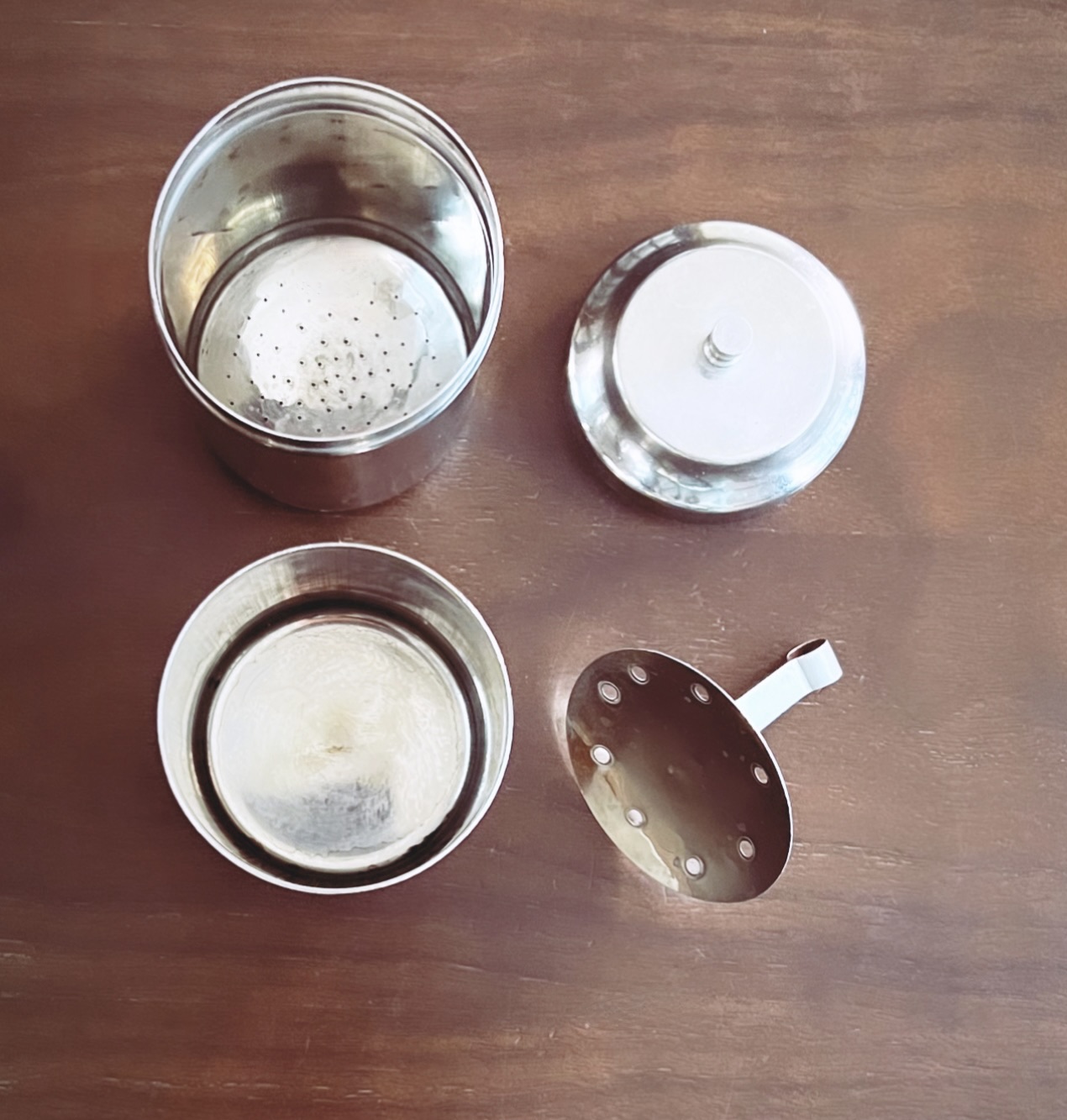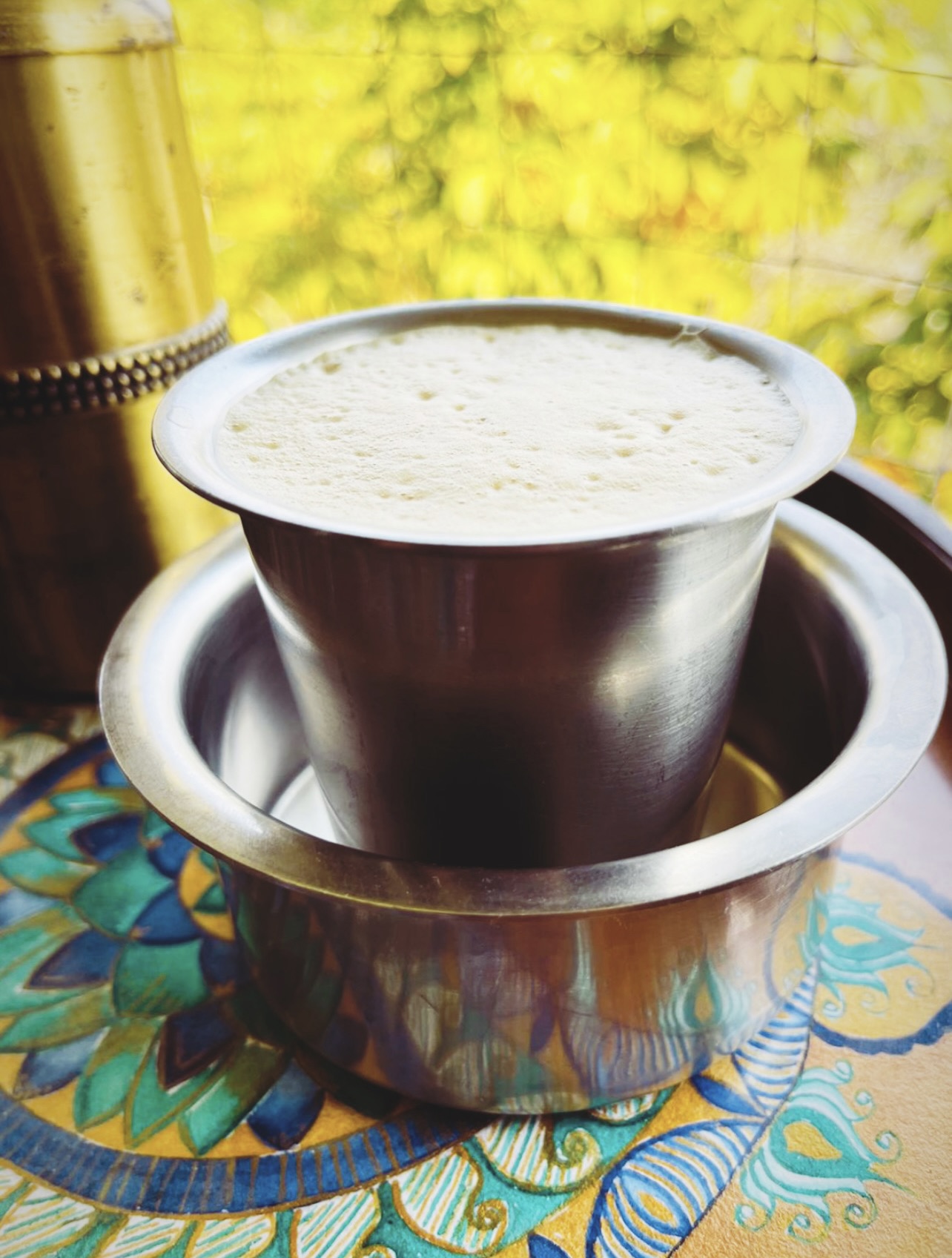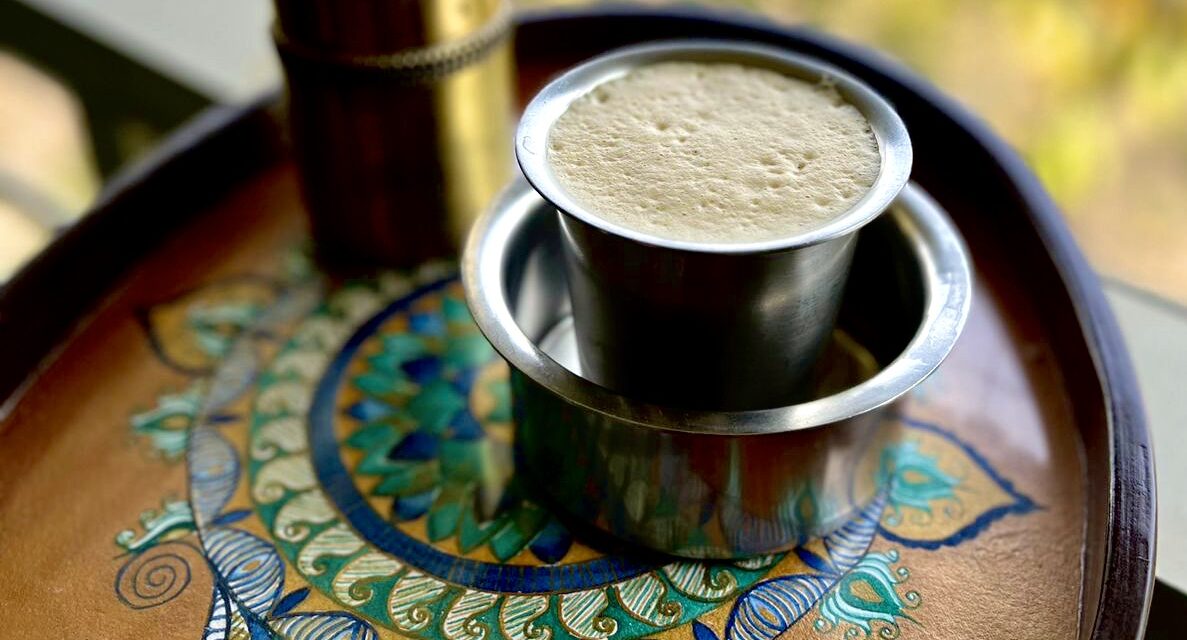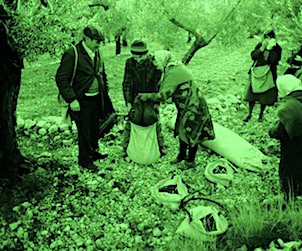A brief History of Coffee Culture in India
If Monsooned Malabar is the tale of how Indian coffee charmed European coffee-drinkers, South Indian filter coffee is the story of how Indians became coffee-drinkers. In my previous piece on coffee, I recounted the legend of Baba Budan, who is said to have smuggled the first few coffee seeds onto the Indian subcontinent in the 16th century. This eventually led to the cultivation of coffee in South India and a growing market for Indian coffee in Europe. It was not until the 20th century, though, that coffee became a part of the cultural and social life of India.
In fact, coffee was originally viewed as a “western vice”, as A R Venkatachalapathy notes in his fascinating essay “In Those Days There Was No Coffee” (if you would like to read more about coffee and its role in middle-class Tamil culture, you can find his essay on Amazon). It was even seen as a bad influence that was corrupting Indian women, which is unsurprising as women have always been viewed as the stewards of traditional culture in India.
By the early 20th century, however, coffee began to replace traditional morning drinks like neeragaram (water, drained after cooking rice, fermented, and salted) in South India and by the 1930s, coffee culture was entrenched in colonial India. In Tamil Nadu, for instance, Venkatachalapathy traces how it was transformed from being perceived as a threat to Tamil identity to becoming an integral part of middle-class social and cultural life. “The darkest condemnation of a family would be the warning uttered at their back, “Their coffee is awful””, he writes.
Today, filter coffee is as Indian as butter chicken. That is to say, it is the result of a confluence of influences, giving rise to a uniquely Indian tradition, woven into the very fabric of life in India. As an old friend who lives in Chennai once observed while we were talking about how important filter coffee is in India, “the best Sari shops will serve you filter coffee, and if they don’t, it’s a snub.”
What is South Indian Filter Coffee and How is it Made?
Classic South Indian filter coffee is made with finely ground coffee beans. Many people use a blend of coffee and chicory rather than just pure coffee. The amount of chicory in the blend can vary and its proportions can change the flavour profile and texture of the coffee one makes – chicory can be quite bitter and it also adds body to coffee.
The apparatus used to make South Indian filter coffee is made up of two chambers, a lid, and a plunger. The upper chamber is perforated with small holes at the bottom. (Interestingly, a similar contraption, known as a phin, is used to make Vietnamese coffee).

What a South Indian Coffee Filter Looks Like
To use this device, one adds ground coffee to the upper chamber, then one pushes the plunger down until it is in contact with the coffee grounds. Next, one fills this chamber with hot water, puts the lid on it, and waits for 20-30 minutes. The water in the upper chamber filters through the layer of coffee trapped under the plunger, then trickles through the holes at the bottom of the chamber into the receptacle below. The resulting extract that collects in the lower chamber is called a “decoction”.
For a traditional cup of filter coffee, this decoction is blended with milk and, sometimes, sugar or jaggery. Then comes the last and most fun part of the process. One pours the coffee into a stainless steel or brass tumbler and from it into a “dabara”, a wider, shallower vessel than the tumbler. This process is repeated: the coffee is poured back and forth, from the tumbler to the dabara, and then again into the tumbler. The most accomplished makers of filter coffee can do this very quickly, pouring the coffee from quite a height, causing it to become very frothy and creamy (here is a link to a video that illustrates the process of making filter coffee, if you are curious). When the coffee is sufficiently foamy, it is ready to drink!

Photo Credit: Avanija Sundaramurti
Pour-Over Coffee versus Espresso: A Frame of Reference
I like to compare South Indian filter coffee to coffee made by the pour-over and espresso methods. This juxtaposition makes it easier to highlight South Indian filter coffee’s distinctive flavour profile and texture. Before I delve into this comparison though, here is a quick primer on how pour-over coffee differs from espresso for those who want a refresher.
At a basic level, these two brewing methods are similar, using water to extract flavour from ground coffee: water passes through coffee grounds, absorbing flavour on its way, then moves through a filter of some form into a receptacle of some sort. There are three key differences in these processes, however: the size of the coffee grounds, pressure, and time. The pour-over method uses more coarsely ground coffee than the espresso method. It also involves the application of less pressure to the water passing through the coffee grounds than the espresso method does. Finally, the water stays in contact with the ground coffee for a longer time during the pour-over method than it does during the espresso method.
These dissimilarities in methodologies manifest as differences in the flavour and density of the resulting coffee. Since the pour-over method uses more water, the coffee it produces is naturally more diluted and less acidic than espresso. In addition, because the water stays in contact with the coffee for a longer time in the pour-over method, it absorbs more subtle flavours, taking on more complexity. Pour-over coffee is therefore less dense and concentrated, with more nuanced, delicate flavours.
What Does South Indian Filter Coffee Taste Like?
South Indian filter coffee is like pour-over coffee in some ways and like espresso in others. The perforations at the bottom of the upper cylinder of the South Indian coffee filter are tiny, allowing only the smallest droplets of water to trickle through them. Moreover, because South Indian filter coffee is finely ground (more finely ground than the coffee used in the pour-over method) the water takes longer to pass through it, staying in contact with the coffee for a longer time. Some argue that chicory contributes to the obstruction or congestion the coffee creates, making the brewing process last even longer. Finally, with South Indian filter coffee, the plunger compresses the coffee, creating an even less permeable layer of grounds through which the water passes.
Consequently, flavour and body are extracted from the coffee gradually, creating a decoction that is more nuanced than espresso and, in that sense, akin to pour-over coffee. On the other hand, this decoction is richer and more acidic and intensely flavoured than pour-over coffee (as less water is needed to extract flavour and body), placing it somewhere closer to espresso on the texture and concentration spectrum.
A Final Note
If this discussion of the many facets of South Indian filter coffee has piqued your interest, many South Indian and even pan-Indian and North Indian restaurants serve filter coffee. If you would like to try making a cup of South Indian filter coffee yourself, you will need a South Indian coffee filter. You can find one easily at an Indian grocery store or online. My parents, lifelong coffee drinkers and passionate filter coffee lovers, say that any coffee can be used to make filter coffee. My father prefers peaberry coffee beans, though (see here for more on this type of bean). Conversations with friends and family in India have led me to believe that peaberry is still considered a “premium” coffee and the preferred type of bean with which to make filter coffee. Many South Indian households take pride in claiming that they use pure peaberry coffee to make their coffee. Others like a blend of any Arabica bean and chicory because it makes for a stronger, more intense, and dense coffee.
A steel or brass tumbler and dabara would serve you well should you choose to add milk and make your coffee frothy, though you could probably replicate this process with cups and glasses that you already have. I can attest to the fact that practicing passing the coffee from the tumbler to the dabara makes for a fun, if messy, game.
However you choose to enjoy your coffee this weekend, I hope it is an enjoyable cup! Until the next time!
Featured Image Photo Credit: Avanija Sundaramurti (the patterned tray in the photo was painted by Shubha Sundaramurti)






